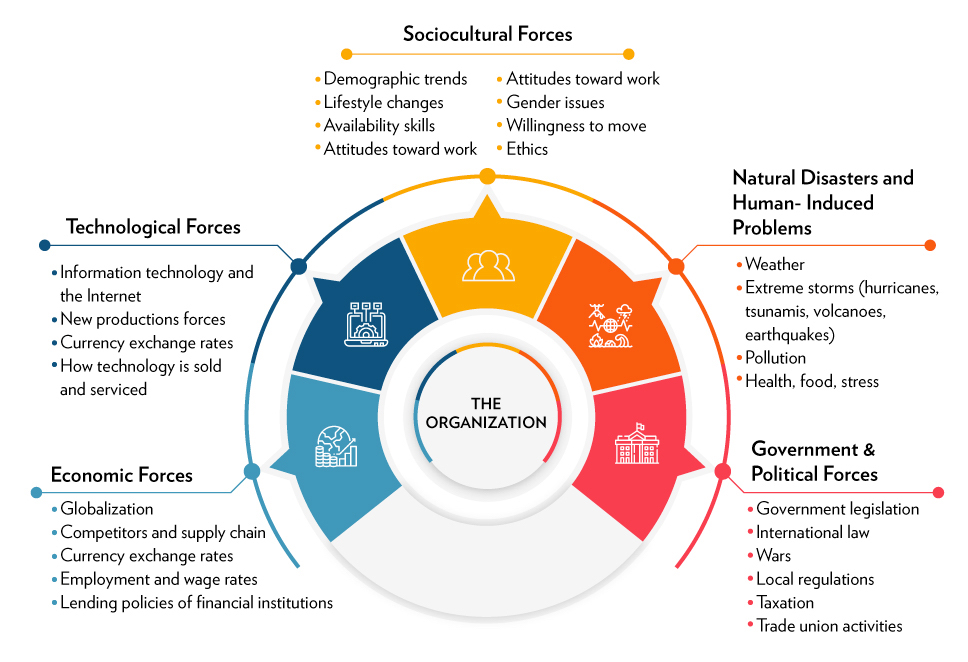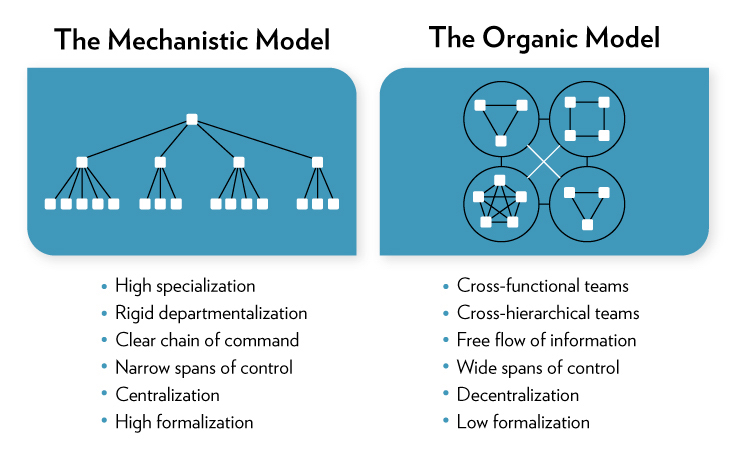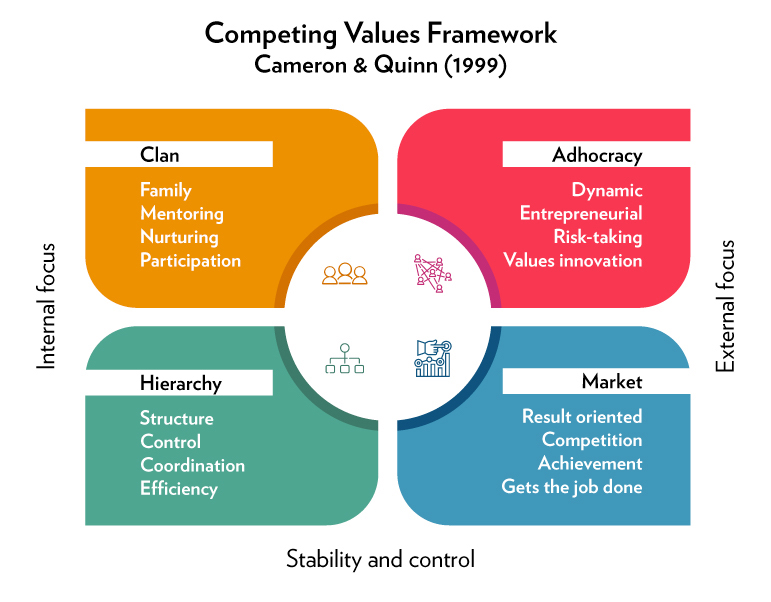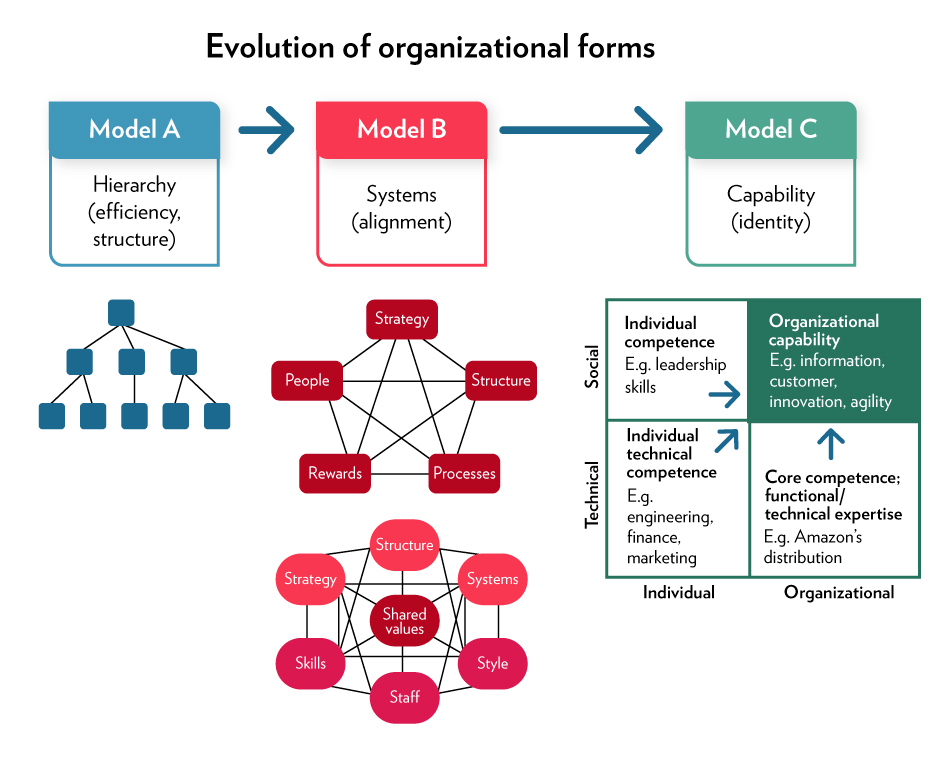Unit 2 External / Internal Organizational Environments and Corporate Culture

Overview
Welcome to Unit 2 where we will discuss organizational environments and culture.
As humans we do not live in a vacuum. We are surrounded by, and interact with, our environment. Our neighbourhood, our schools, community centers, banks, workplaces, restaurants, libraries, shopping centers and malls are examples of our environment. We are constantly interacting, receiving inputs and outputs from these quarters. Our success in life depends on how we process manage and respond to these inflows and out flows. Like humans, organizations do not exist in a vacuum. Their success depends on how effectively they respond to their external environments.
Our response as humans to these inflows and outflows from our environment varies from individual to individual. Some of us may proceed cautiously, others with great speed – willing to take risks. Some of us venture out alone, others will consult peers and elders prior to deciding. There are times we will move ahead alone and times we will move in a group. Some will handle one aspect at a time, others will multitask and take on a few factors simultaneously. The varied response factors in our personality, our family structure, our culture, our past experiences, and other internal factors unique to us. Similarly, the way organizations respond to their environment varies form organization to organization. The structure and culture of the organization are important determinants in this response.
In Unit 2, we look at:
- the external and internal environments of organizations; the threats and the opportunities; the internal strengths of the organization.
- the importance of organizational structure and culture in motivating people in the organization to respond to these threats and opportunities in a strategic and effective manner.
Topics
This unit is divided into the following topics:
- The Organization’s External Environment
- External Environments and Industries
- Organizational Designs and Structures
- The Internal Organization and External Environments
- Corporate Cultures
- Organizing for Change in 21st Century
Learning Outcomes
When you have completed this unit, you should be able to:
- Analyze the external and internal environments of an organization
- Describe the elements that constitute the internal and external environments of an organization
- Contrast healthy organizational cultures with toxic organizational cultures
- Determine the importance of a healthy organizational culture to organizational success in the 21st century
Activity Checklist
Here is a checklist of learning activities you will benefit from in completing this unit. You may find it useful for planning your work. Total time for activities: 2 hours
Learning Activities
- Read section 4.1 in your text and list internal and external environmental factors that affect an organization.
- Read section 4.2 and match the level of certainty to the environmental factors.
- Read section 4.3 and identify descriptions of the organic or mechanistic organizational structure.
- Read section 4.4 and reflect on the questions provided.
- View Exhibit 4.21 on your text on the Competing Values Framework and answer the questions provided.
- View the resources by David Ulrich on Market Oriented Ecosystems and Reinventing the Organization.
Assessment
- Unit 2 Team Memo (Please confirm assignment instructions in Moodle)
Resources
Here are the resources you will need to complete this unit.
- Bright, D. S. & Cortes, A. H. (2019). Principles of Management.
- Other online resources will be provided in the unit.
2.1 The Organization’s External Environment
There are numerous organizations in the world, focusing on a range of objectives. The list below gives us an idea on the range of organizations that exist today.
- Governments
- Non-Governmental Organizations
- Political Organizations
- Corporations
- Schools
- Charities
- Not-for-Profit Organizations
- Voluntary Associations
- Armed Forces
- International Organizations
- Secret Societies
- Resistance Movements
- Criminal Organizations
A very simple definition of an organization is that it is a group of people structured and managed to meet a need or to pursue a collective purpose. No organization exists in a vacuum. Every organization operates within its unique environment. There is the environment within the organization, called the internal environment, and the environment outside the organization, called the external environment. We will look at these in detail in Topics 2 and 4 respectively. But for now, Figure 2.1 (below), provides a snapshot of an organization in the context of its internal and external environments.

Figure 2.1: An organization and its environment
Figure 2 provides a graphical representation of an organization in the context of its internal and external environment. In this unit, we will be looking at the internal and external environments of the organization in detail. In Figure 2, the heart at the center represents the life of the organization – the vision, mission and core values make the organization tick and give it purpose and direction. We will be unpacking mission, vision, and core values in detail in unit 4. The white section in Figure 2 represents the internal forces acting upon the organization. Allocation of resources (human, financial and physical), the structure of the organization (topic 3) and culture of the organization (topic 5) are key internal forces that leaders of the organization must manage.
Figure 2.2 below provides a detailed picture of the external environment of an organization. The diagram presents the 5 groupings of an organization’s external environment and a detailed list under each grouping. Some texts refer to these factors that constitute the external environment of an organization as the SLEEPT or PESTEL factors (political, economic, social, technological, environmental, legal).
Understanding the factors that make up the external environment are critical to the success (or failure) of the organization. Below are some examples:
- A continuously unstable or volatile political climate might mean that the organization must critically evaluate the resources it is allocating.
- Government policies and legislature in the country impact hiring policies, unionization, compensation, and other human resources functions
- Government policies impact tax structures
- The environmental factor considers weather patterns, hurricanes etc. in setting up structures, transportation etc.
- Technological factors evaluate level of internet connectivity, power supplies etc.

Figure 2.2: Macro Forces and Environments from Principles of Management, Rice University, OpenStax, under CC-BY 4.0 license.
Activity: List Environmental Factors
Read section 4.1 in your textbook, Principles of Management. Based on your readings and understanding of Figure 2.1 and 2.2 (above), compile a list of internal and external environmental factors that affect your organization (or an organization you are familiar with, or have a discussion with someone who works in an organization).
Questions to Consider
After completing the activities above, consider the following questions:
- What are some ways that environmental factors can impact the success or failure of the organization you serve?
Note that the learning activities in this course are ungraded, unless specified. They are designed to help you succeed in your assessments in this course, so you are strongly encouraged to complete them.
2.2 External Environments and Industries
In our previous topic, we recognized that no organization operates in a vacuum. Every organization is impacted and influenced by forces and factors from within the organizations and from the world at large. Understanding both these forces and factors (internal and external) is crucial to achieving success as a business. Businesses are involved in meeting needs, providing solutions and services in diverse industries – ranging from hospitality, IT, manufacturing, healthcare, manpower, engineering, education, to non-profits. Some organizations, like multinational organizations, are involved in several of these industries. Each industry has its own challenges, trends, issues, and opportunities. So, the question is, “How do organizations decide which industries they must enter?” The following questions may help in making that decision:
- Has PESTEL, SWOT analyses been done?
- How volatile/stable if the external environment?
- To what extent will they immerse themselves in these industry/industries?
- How much of resources will they commit?
- How many competitors are present? Is the industry crowded?
- Is there room for a new entrant?
- Have risk management assessments been done?
- Does the organization possess the internal resources to enter this industry?
- What factors are attracting the organization to enter this industry?
- Is this a short term or long-term involvement?
- Is the need a passing fad?
- Have sustainability issues been studied by the organization?
- Have the staff been consulted and involved in the decision?
- Do staff need to be retrained for this new venture?
- Will they need to draw in human resources from outside the organization?
Exhibit 4.4 (section 4.2 in text), provides a helpful guide on the organization – industry “fit” or alignment that needs to be considered to perform in rapidly changing environments. Depending on the environmental complexity, organizations may have to strengthen, modify their own capabilities from within
Activity: Matching Levels of Certainty
Read section 4.2 in your textbook, Principles of Management Then, match the level of certainty to the environmental factors.
Questions to Consider
- How have changes and shifts in technologies over the last 2 years, created challenges and opportunities for your organization? Think of some examples.
- How did your organization respond to these shifts?
2.3 Organizational Designs and Structures
Every living organism has design and structure. Examples of design and structure abound in the plant and animal worlds. Our human bodies are also wonderful examples of structure and design. For instance, cells - considered to be the basic structure or unit of the human body, make up tissues, which in turn form specialized structures called organs. Each organ is structured to support the function of other organs, and groups of organs and tissues all function together in a structured systematic manner towards a single purpose of maintaining the health and growth of the body. The functions of these organs are supported by muscle and bone structures. Communication amongst organs takes place through the nervous and hormone(endocrine) systems via electrical and chemical signals that pass between cells. When organs do not fulfill their designed role or if communication breaks down, the result is ill health and external intervention is required. Structures and design layout the plan, provide support and facilitate growth.
Likewise, in organizations, structures help connect individuals and teams to achieve overall organizational goals and objectives. Organizational structures and designs are valuable to achieving coordination and management of resources, as they: (1) specify reporting relationships (who reports to whom), (2) delineate formal communication channels, (3) describe how separate actions of individuals are linked together and (4) lay out how reporting relationships govern the overall workflow of the organization, (5) eliminate unnecessary ambiguity, confusion and lack of accountability. As individuals carry out their designated responsibilities, they contribute towards goals of their teams, and as teams reach their goals, the organization moves steadily to health and growth.
Gill Corkindale in a well written article titled, The Importance of Organizational Design and Structure says,
“Poor organizational design and structure results in a bewildering morass of contradictions: confusion within roles, a lack of co-ordination among functions, failure to share ideas, and slow decision-making bring managers unnecessary complexity, stress, and conflict”.
Thus, organizational structure and design dictate organizational health and growth (or the lack of it!). Our readings for this topic provide an overview of the types of organizational structures and designs.
While Unit 6 provides further insight into how organizational structures and designs need to be crafted based on the vision, mission, and core values of the organization, for now we will take a brief tour of the types or organizational structures and designs. Organizational structures fall in to one of two configurations: (1) Mechanistic (2) Organic (see figure below).
An organization with a mechanistic structure is highly formalized and centralized. Communication lines are clear and flow through formal channels and such organizations are rigid and typically resistant to change. While mechanistic structures maximise organizational efficiency, and minimise costs a stable environment, they can stifle innovativeness, autonomy, and self determination.
Organic structures, in contrast are flexible and decentralized. In organic structures, communication is fluid and flexible, job descriptions are broader and need based, and foster entrepreneurial and innovative thinking amongst employees.

Figure 2.3: Mechanistic versus Organic Model of Organizational Design. From Essentials of Organizational Behavior, 14/e by Robbins & Judge.
Activity: Readings on Organizational Structures
Read section 4.3 in your textbook, Principles of Management. From the list of words below, identify which describes the organic or mechanistic organizational structure best?
- Team decision making
- One way communication
- Flat organizational structure
- Narrow span of control
- Very rigid, many rules
- Very hierarchical
- Flexible
- Strict on processes
For further reading, see 7 Types of Organizational Structures + Examples, Key Elements. This is a helpful article that deals with the basics of organizational structures and designs, types of organizational structures and design, and an 8 step process on how to design an organizational structure.
Activity: Investigate and Reflect
- Have a conversation with a friend who works for an organization and get an understanding of their organizational structure. Is it more mechanistic? Or more organic?
- All else being equal, would you prefer to work in a mechanistic or organic structure? Why?
Ethical Guidelines for Interviews
Just a reminder to follow ethical guidelines when interviewing.
- Identify the course you are taking.
- Explain the purpose of your questions (e.g. ungraded learning activity to explore course concepts).
- Assure the participant that your conversation is confidential and optional.
2.4 The Internal Organization and External Environments
In Topic 2, we noted the dynamics of the rapidly changing global environment in which organizations operate. This has been referred to as the VUCA (Volatile, Uncertain, Complex, Ambiguous). If an organization is to succeed in a VUCA environment, it must possess the right internal structure to adapt and respond accordingly in a timely manner. Our readings for this unit, introduce a management approach called the Open System Model (Exhibit 4.15) that can help organizations in any industry respond to changes rapidly. The model explains how organizations need to respond to their external environments and the place of internal dimensions and structures in determining the right response.
In an open system, there is constant receiving and giving of information between the organization and its environments (both internal and external). In contrast, a closed system operates with little or no influence from outside forces. Workers in a closed system, have very little communication with other departments on their activities. Examples of closed systems: Independent assembly lines, research and Development division, Trade secrets documentation division etc. A large, publicly traded organization is an example of an open system. The organization takes in resources and other forms of inputs from its internal and external environment, transforms, adds value and places them back into the environment. As seen in the diagram below, an organization must manage the inputs (inflows) and outputs (outflows) of its interactions with its environment.

Figure 2.5: Open System Model of an Organization from Principles of Management, Rice University, OpenStax, under CC-BY 4.0 license.
In Topic 5, we will look at one very important internal dimension of an organization – organizational culture.
Activity: Compare and Reflect
Read section 4.4 in your textbook, Principles of Management. Consider the following questions:
- What is the difference between an open and closed system?
- Compare the advantages and disadvantages of using the two types of systems.
2.5 Corporate Cultures
The culture of an organization is one of the most important internal dimensions and has been described as the glue that holds the organization together. Organizational culture is about how things get done in the organization, how employees respond, and their level of motivation. An organizations culture can be its strongest asset or its biggest liability. Organizational cultures, like national cultures are based on values, and are framed and influenced by leadership at the top. Organizational cultures can bind and bond teams together in unity. Such organizations can respond to change and volatile market conditions effectively with speed and agility. At the other end of the spectrum, organizational cultures can also create and breed disunity, fractions and conflict. Power politics, disengaged employees, low productivity are evident in such cultures. Such cultures are referred to as toxic organizational cultures. Building and maintaining a healthy organizational culture is important in facing the VUCA (Volatile, Uncertain, Complex, Ambiguous) environment of the 21st century.
Here are 9 Signs of a Toxic Organizational Culture:
- Authoritarian style of leadership
- High rate of turnover
- Unmotivated team members
- Resistance to change and learning
- No clear vision and core values
- Competition over collaboration
- Poor communication
- Cliques and gossip
- Little or no employee recognition
Activity: Comparing Organizational Values
Figure 2.6 explains the Competing Values Framework by Cameron and Quinn (1999). Can you think of an example for each quadrant? In which quadrant would your organization fit? If your organization was to be successful, which quadrant should it operate in? Why?

Figure 2.6: The Competing Values Framework from Principles of Management, Rice University, OpenStax, under CC-BY 4.0 license.
2.6 Organizing for Change in 21st Century
Operating in a VUCA (Volatile, Uncertain, Complex, Ambiguous) environment, where the only constant is change, organizations need to constantly reinvent themselves, though innovation and experimentation. Complacency, failure to adapt to changing market conditions will lead to irrelevancy and eventual demise. Kodak, Blackberry, Blockbuster, Sears, and Toys R Us are examples of organizations that failed to reinvent and respond to the VUCA environment. Customer-centricity, delivering value to all stakeholders, innovation, agility, are hallmarks of organizations that have successfully reinvented themselves in the VUCA environment we operate in today.
Dave Ulrich and Arthur Yeung have written an outstanding book called Reinventing the Organization (see website). One of the topics dealt with is the evolution of organizational structures. The three figures below provide a quick snapshot of this evolution.

Figure 2.7: Evolution of Organizational Forms by David Ulrich in The Emergence of the Market-Oriented Ecosystem (MOE) Organization
The work of Ulrich and Yeung drive home the point that organizations not willing to constantly reinvent, adapt structures and cultures to stay geared to the changing times, are doomed for irrelevance and eventually closure.
Activity: Resources on Evolving Organizations
- Read the article by David Ulrich, The Emergence of the Market-Oriented Ecosystem (MOE) Organization, to understand how organizations need to evolve to succeed for the future. Write down three insights you would apply to your organization. (Article is also available on his LinkedIn site).
- For further insight, watch Dave Ulrich being interviewed on Reinventing the Organization.
Unit 2 Summary
In this second unit, you have had the opportunity to learn about:
- The external and internal environments of an organization
- The types of organizational structures
- Healthy and Toxic organizational cultures
- The importance of the right culture and structure to build successful organizations to successfully respond to the uncertainties of the future.
As leaders and administers of organizations, it is important to be sensitive to new trends, paradigm shifts in the world, potential future markets and how the organization needs to constantly position itself to deal with and respond to these shifts. The rest of the units, help us in developing our administrative competencies in order to manage and lead our organizations into the future.
Personal Application
Before participating in the assessment for this unit, consider how you might apply what you have learned.
- Assume you are leading/managing a: (a) small division in an organization, (b) small scale start up, or (c) ministry team in church.
- Pick one of these three scenarios and write a 1–2-page memo to your team on the importance of one topic covered during your readings for the week.
- The memo to the team will emphasize the importance of applying this topic/ practice for organizational success and will include specific steps to motivate team members to implement these initiatives.
Please see the Assessments section in Moodle to confirm assignment instructions, including the grading criteria and due dates.
Checking Your Learning
Before you move on to the next unit, you may want to check to make sure that you are able to:
- Analyze the external and internal environments of an organization
- Describe the elements that constitute the internal and external environments of an organization
- Contrast healthy organizational cultures with toxic organizational cultures
- Determine the importance of a healthy organizational culture to organizational success in the 21st century